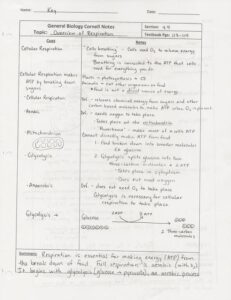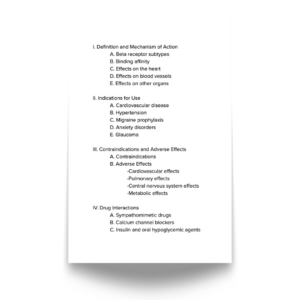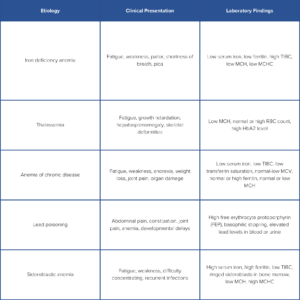5 Note-Taking Methods to Keep You Organized During Medical School
- by
- Apr 20, 2023
- Reviewed by: Amy Rontal, MD

As a medical student, staying organized and retaining vast amounts of information is crucial for success in exams and clinical practice. Memorization and improved understanding of so much information can only come through repetition, and doing this in an effective way will require some serious organization skills. In this post, we’ll dive into five note-taking methods that can help you stay organized and retain information as you prepare for any exam.
5 Note-Taking Methods for Medical Students
#1: The Cornell Method
This approach is best used when putting together notes early in your studying, such as learning pathology and pathophysiology during preclinical classes. The Cornell Method involves dividing a sheet of paper into three sections. The first section is for notes, the second section is for key points or questions, and the third section is for summarizing the notes.
This popular method helps you to organize your notes and makes it easier to review them later. For med students, this style is best used when putting together notes early on in your Step 1 prep, such as learning pathology and pathophysiology during preclinical classes.
For instance, if you are studying the cardiovascular system, you might divide your paper into three sections. You could take notes on the anatomy of the heart and blood vessels (1), write down key points on the physiology of the cardiovascular system (2), and then summarize the mechanisms of cardiovascular diseases and treatments (3).
Here is an example:
#2: Mind Maps
Mind maps are a visual note-taking method that involves creating a diagram to connect different pieces of information. This method is especially useful for visual learners who need to see connections between different concepts.
For example, let’s say you are studying microbiology. You could create a mind map of different bacterial species (e.g., Strep pneumo) and their characteristics (Gm positive). Then you could write the name of the bacteria in the center of the page, and draw branches out to include information on its morphology, virulence factors, associated diseases, etc., as shown in this example:
#3: The Outline Method
The outline method is a hierarchical note-taking method that involves using bullet points to organize information. This method is useful for capturing the structure of a lecture or textbook chapter.
Here is an example of an outline for beta-blockers (not filled in):
#4: The Charting Method
The charting method is a note-taking method that involves creating a table to organize information. This method is especially useful for organizing information that has clear categories or comparisons. Many Qbanks have charts/tables as part of their answer explanations, and if you already use one of these, then you likely appreciate the value they bring.
Here is an example for studying the etiologies of microcytic anemia:
#5: The Sentence Method
The sentence method is a simple note-taking method that involves writing down notes in complete sentences. For example, if you are studying the respiratory system you could write “Tidal volume is the volume of air inspired or expired with each normal breath.” You could take it a step further by making a flashcard and splitting the sentence in two, with “Inspiratory reserve volume is” on one side of the card and “the maximum volume of air that can be inspired after a normal inspiration” on the other.
This method is useful for capturing important details and can be especially helpful for students who prefer to write in complete sentences. When using it, keep the sentences simple and put them in your own words as much as possible, rather than copying verbatim from the source. It’s a good approach, but it may not be for everyone, especially those who prefer to keep shorter notes.
Further Reading
Note-taking is an essential skill for preparing for med school exams. By using any of the methods outlined above, you can stay organized, make connections among different concepts, and retain information more effectively. With the right note-taking strategy, you can approach Shelfs or USMLEs with confidence and achieve your goals.
If you are interested in learning more about studying during med school, check out these other blog posts:
- How to Study For Shelf Exams: A Tutor’s Guide
- Step 1 Pass Rates Are Decreasing: How to Make Sure You’ll Pass
- How to Prepare for Step 2: A Few Questions to Ask
If you are interested in learning more about the methods discussed in this article, check out these references:
- Bunce, D. M. (1997). The role of recall time in creating a context for learning from lecture. Applied Cognitive Psychology, 11(5), 407-415.
- Slater, R. O., & Stebbins, R. A. (1991). Improving classroom performance by enhancing note-taking. Teaching of Psychology, 18(3), 151-153.
- Pauk, W. (2001). How to study in college (7th ed.). Boston, MA: Houghton Mifflin.
- Walter, C., & Stovall, J. (2019). The Cornell note-taking system. CRLT Occasional Papers, 34.
- Notetakingexpress.com. (n.d.). Charting method. Retrieved from https://www.notetakingexpress.com/charting-method
- Farrand, P., Hussain, F., & Hennessy, E. (2002). The efficacy of the mind map study technique. Medical Education, 36(5), 426-431.
- Buzan, T. (1993). Use both sides of your brain: New mind-mapping techniques. New York, NY: Plume.
- Furtak, E. M., Seidel, T., Iverson, H., & Briggs, D. C. (2012). Experimental and quasi-experimental studies of inquiry-based science teaching: A meta-analysis. Review of Educational Research, 82(3), 300-329.
- Conley, M. A., & Lufkin, J. L. (2015). Improving learning outcomes with graphic organizers: From research to practice. Journal of Education and Practice, 6(3), 1-13.
About the Author
Navin studied Biochemistry at Santa Clara University, attended Georgetown University School of Medicine, and is a current resident physician at the Internal Medicine Residency at TriStar Centennial Medical Center 2. Navin has been working for Blueprint since 2020 and has general interests in medical education, trends in medicine, and wellness.













